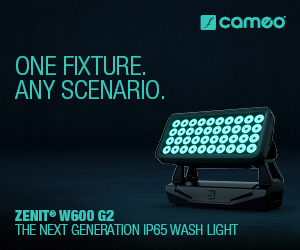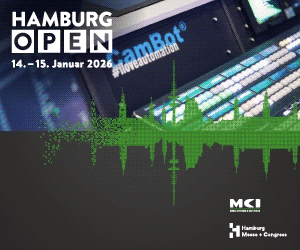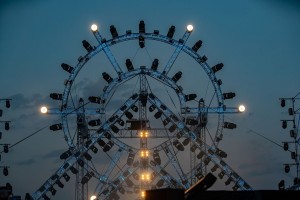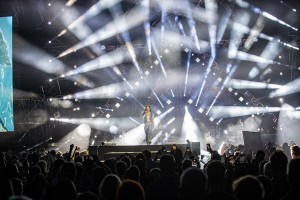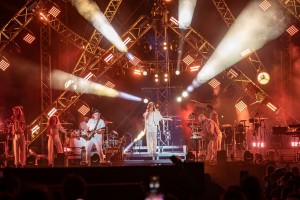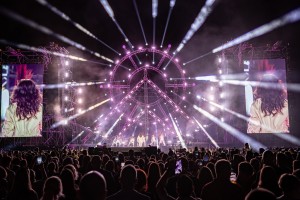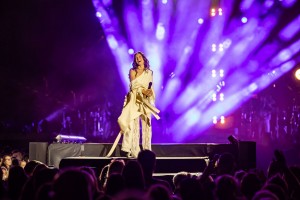Aktuelle News & Schlagzeilen
Nina Puslar homecoming concert lit with Robe
Slovenian singer/songwriter Nina Puslar rocked her hometown of Ivancna Gorica, forty kilometres out of Ljubljana, for a homecoming concert at the football stadium, celebrating twenty years of success in the music industry.
Lighting designer Crt Birsa of design studio Blackout produced a carefully sculpted lightshow crafted for the scale of the occasion. He utilised nearly 200 Robe moving lights among his 500-plus fixtures to impress Puslar’s audience, which included Slovenia’s President Natasa Pirc Musar, who sat in one of the VIP areas.
Birsa and his team at design studio Blackout have been working with the artist for around fifteen years, looking after the lighting and visuals since her early career, which has skyrocketed in that time. A major starting point for lighting this show was the venue, which had never staged anything this huge or complex before. Birsa had plenty of input from Puslar herself, who wanted to create something truly spectacular.
He worked with regular collaborators - set designer Greta Godnic and production manager Rok Lozar. An early suggestion was having a Ferris wheel behind the stage which could also help facilitate lighting positions. After much discussion, with unpredictable weather in mind, this morphed into inspiring Birsa and Godnic to create the circular trussing architecture that defined the performance space, which was based around a large 12-metre diameter trussing circle giving a maximum height of 22 metres, with spikes connecting it to a smaller 6-metre diameter inner circle.
Two angled truss pieces either side formed triangles descending from the central point in the middle of the circle. Two side IMAG screens were rigged to two front Layher towers flanking the stage, together with the main PA hangs, with another two single span truss towers either side of the FOH position providing positions for front lighting fixtures and follow spots.
Robe is a brand that is constantly appearing on Birsa’s designs, so it was a go-to for this one, especially as rental company Intralite - which supplied the full technical production - has a large inventory, supplied over the years by Robe’s Slovenian distributor MK Light Sound. A critical element of the design was that there was no upstage centre video screen - just the two portrait left and right IMAGs - so a lot of visual emphasis was on the lighting design. It had to provide a cool backdrop as well as effects and practical lighting.
The first fixtures on the plot were 58 MegaPointes, positioned all over the four towers and triangular trusses. Thirty-two Pointes outlined both sides of the thrust stage/runway, which were used in conjunction with the MegaPointes for primary and augmenting beams. The structural form of the trussing naturally lent itself to producing numerous big and dramatic beamy looks.
Fourteen Fortes were positioned on the upstage edge of the stage and used for backlight. Birsa chose 32 Spiider LED wash beams for the main onstage wash coverage, dotted all over the Layher scaffolding of the side towers. Eight iForte LTXs rigged on the delay towers were used for front and key lighting.
For this show, Birsa was running three RoboSpot systems each controlling two lights at a time. Two of these key light RoboSpot base stations were positioned at the bottom of the delay towers, and the third was backstage. The backstage one controlled an iForte LTX rigged right at the top of the large circle and a Forte at the apex of the larger triangle, both used for backlight when the artist was working along and at the end of the thrust.
Two fixtures a side of the eight iForte LTXs on the front towers were also RoboSpot controlled for key lighting and specials on the band, and for guests of which there were several, including the Sticna Quartet, who have accompanied Puslar since the start, and the Sticna Elementary School children’s choir, under the direction of her first singing teacher.
Birsa used 32 Robe ParFect 100s as the truss toners for both circles and their connecting trusses. Sixteen LEDBeam 150s were deployed along the front of the stage, providing low-angle key light for the band, helping eliminate shadows which was important as the show was recorded live by Digital 3 Production. “This rig was a combination of both classic and contemporary Robe fixtures”, notes Birsa.
As there was no stage roof (which was another aesthetic decision), all the lighting had to be ground supported. Starting in daylight and the show being a one-off, it was also vital to make an impression in the first few numbers, so Birsa did not hold back on revealing a series of stunning lighting looks. The design also had to be adjusted to differing natural lighting states - daylight through dusk and into darkness. Staged a day before the midsummer solstice, there was more daylight than darkness in the equation.
Haze management was galvanising and is always an unknown in an outdoor environment. Despite copious expertise and fifteen haze machines at his disposal with strategically calculated fanning devices all over the stage, Birsa thinks there could have been more.
Programming time on site was very limited. For some of the songs, Birsa developed an extended update to the existing programming from his Blackout colleague Amadej Superger, who looked after lighting on Puslar’s last arena show, and for the new material presented in Ivancna Gorica he programmed from scratch, consuming around eighteen days of pre-vizz followed by two half nights on site with the full rig. Blackout’s Klemen Krajnc took care of key lighting programming throughout this process, leaving Birsa free to focus on developing the big picture looks, effects and overall aesthetic.
(Photos: Louise Stickland/Paul Clarke)
SCHLAGZEILEN
news archiv
suche
© 1999 - 2025 Entertainment Technology Press Limited News Stories

